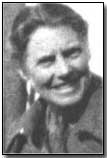Feature Articles - The Life of Evelina Haverfield - War in 1914 and the Scottish Women's Hospital in Serbia
 When war broke out in 1914 Evelina was 47 years old, a mature and
seasoned fighter for human values that she strongly believed to be
important.
When war broke out in 1914 Evelina was 47 years old, a mature and
seasoned fighter for human values that she strongly believed to be
important.
Because of her many years of outdoor activities, in all kinds of weather, she was able to work long hours under adverse conditions. And she could face dangerous situations when others' safety depended on her action.
She had a strong desire to support the war effort and to become active in the most effective manner. During the first six months of the conflict, because of the fear of an enemy invasion of Britain, she was occupied with developing women's organizations in support of the war. But as the conflict in France and Belgium settled down into static trench warfare, the possibility of an invasion became less likely, and Evelina looked for a more demanding role.
In the spring of 1915 she volunteered for overseas service with the Scottish Women's Hospitals, an organization founded and led by Dr. Elsie Inglis, a gifted Edinburgh surgeon.
The total commitment of the S.W.H. organization was to provide medical care for wounded allied soldiers wherever they served. In Serbia their care spilled over to include some of the civilian population. As part of this team headed by a strong and effective leader, Evelina became completely devoted to the welfare of the Serbian people.
She admired both the soldiers' capacity to endure pain during their medical treatment, and the simple classless society of the Serbian nation. She went out to Serbia in April 1915 with Dr. Inglis and enough doctors, nurses, and support staff for three 100-bed hospital units.
Dr. Inglis had sent one S.W.H. unit to Serbia during the previous winter, but because of the primitive living conditions which existed there, and the misery created by two successive invasions by the Austrian Army during the early months of the war, also the havoc wrought by a typhus epidemic during the winter, the first group of "Scottish Women" found that they were completely swamped by the demands of the situation.
As a consequence, Dr. Inglis rapidly recruited enough personnel for three more units destined for Serbia and decided to go out with them. She invited Evelina to join the contingent as an administrator.
They arrived in early May in the Serbian town where the first unit was operating, about 100 miles south of the Serbian border with Austria and Hungary. During the summer, Dr. Inglis established the three new units in small towns close to the northern border with the enemy, in anticipation of future battle casualties.
Serbia was expecting another invasion from the north, as soon as the Austrians felt sure of success. Because of the urgency of the situation, Evelina toiled long hours completing all the many details necessary for establishing sites, staff accommodation, transportation, and ensuring supplies and services needed for the smooth operation of these several units.
After spending enough time in the first location to reorganize the original unit to handle many more patients, Evelina was sent to one of the frontier hospital units to work there with Dr. Edith Hollway, the medical doctor in charge.
In the town where the unit was located, there was a Serbian Army contingent commanded by a cavalry officer whose support and cooperation the S.W.H. needed. At first polite, but reserved in his feelings about a hospital operated entirely by women, he later developed a real respect for the Scottish Women when he observed Evelina's great skill with his cavalry horses.
Next - Austrian Invasion of Serbia
"Drum Fire" was an artillery barrage fired not in salvo but by each gun in succession.
- Did you know?
